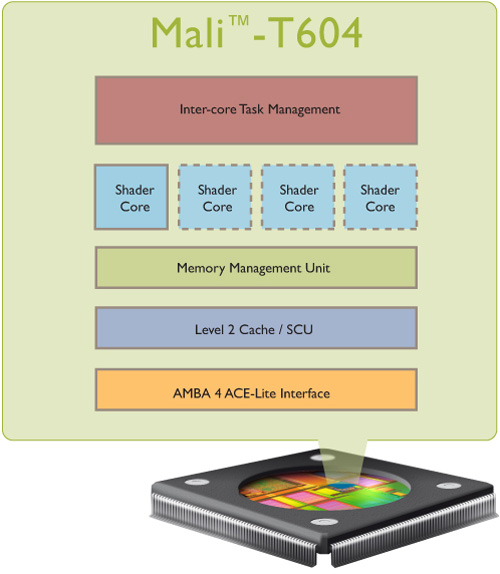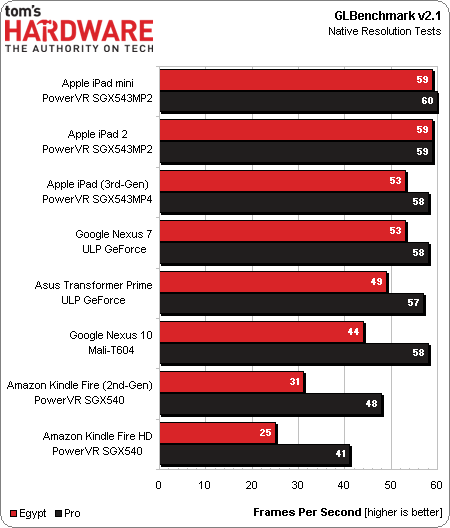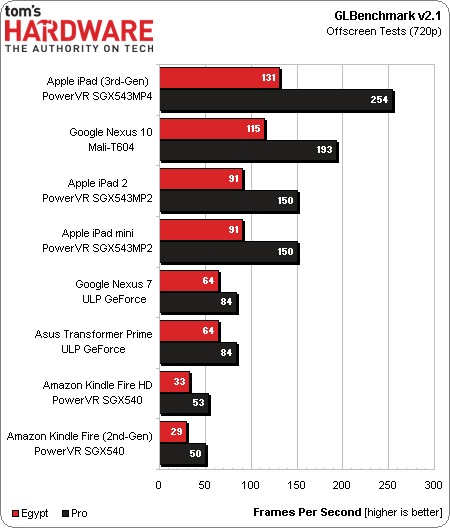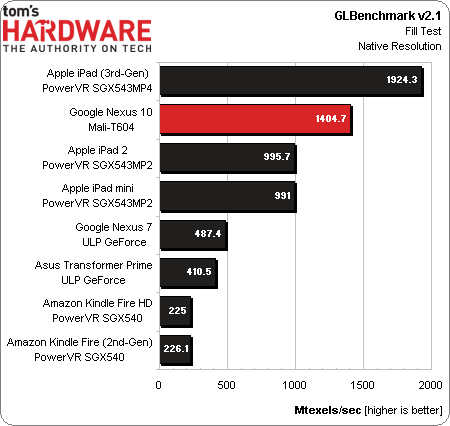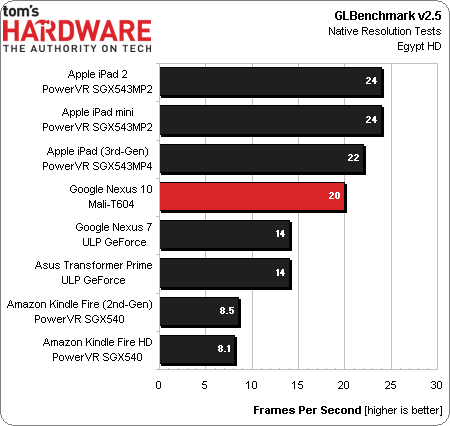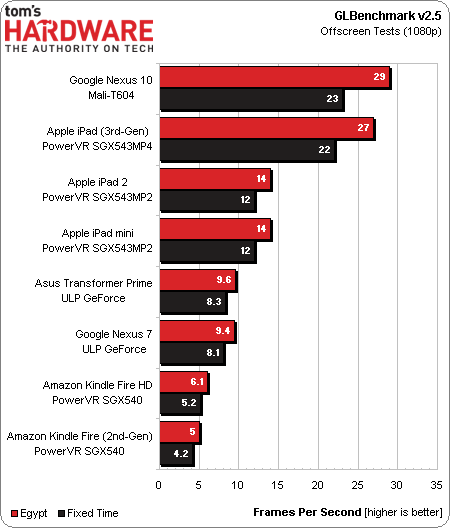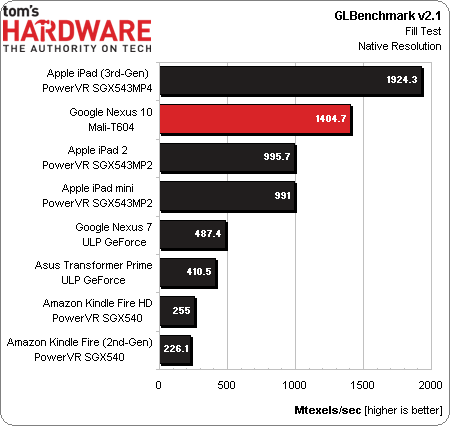Google Nexus 10 Review: Is 2560x1600 High-Def Enough?
Results: GPU Performance
We don't have the explicit pricing data to prove it, but ARM's Mali GPUs have to be some of the most value-oriented designs available, which is why cheap SoCs like Allwinner's A10 employ the Mali-400 MP. The performance of that design isn't particularly impressive. However, the Mali-T6xx family is based on a new architecture called Midgard that promises significantly better results (up to five times higher, according to ARM).
ARM chooses not to divulge much of its architectural detail. However, the simple fact that Exynos 5 Dual offers so much memory bandwidth, seen on the previous page, suggests that a much more powerful GPU wouldn't be hamstrung by a lack of throughput, which is particularly important given the Nexus 10's native resolution. Fortunately, tests like GLBenchmark allow to dig into subsystem performance at a more granular level.
The native resolution tests are device-specific, looking at a given graphics processor rendering on a specific tablet's screen. GLBenchmark 2.1 suggests that ARM's Mali-T604 at 2560x1600 is faster than the Kindle Fire's PowerVR SGX540 at 1280x800, but it's slower than third-gen iPad's PowerVR SGX543MP4 engine at 2048x1536.
Taking the same tests off-screen removes resolution from the equation, narrowing our analysis to further emphasize the GPU. Freed from the Nexus 10's demanding native resolution, we see ARM's Mali-T604 serving up exceptional performance, second only to the quad-core PowerVR SGX543MP4 in Apple's third-gen iPad.
Compared to other devices, the Mali delivers 25% more performance than the SGX543MP2 in Apple's iPad 2 and iPad mini, and between 80 and 130% more than Tegra 3.
Even at 2560x1600, tons of memory bandwidth helps the Nexus 10 overtake its Tegra 3-based competition at much lower resolutions when we apply higher-quality textures in GLBenchmark 2.5.
The off-screen test of this more-demanding version of GLBenchmark shows just how much ARM's Midgard architecture relies on taxing workloads in order to show off its potential. We see the Exynos 5 Dual's Mali-T604 solution top the chart, ahead of the A5X's SGX543MP4.
Get Tom's Hardware's best news and in-depth reviews, straight to your inbox.
Current page: Results: GPU Performance
Prev Page Results: CPU Performance Next Page Results: Web-Based Performance-
joytech22 The Nexus 10 is one of the most powerful Android devices available, but why?Reply
A T604 can be configured up to what - 8 cores? The Nexus 10 has ONE and it performs just under a PVR 543MP4
The CPU is absolutely monstrous, as is RAM Bandwidth, resolution etc..
I often think to myself - Why aren't other manufacturers sticking specs like these into their own systems? Stick a T604MP4 in there and you've got performance numbers (mind you, numbers likely not real-world) close to 2.5x that of the fastest iPad in every single way (except battery.. Lol).
As for CPU, Stick a 1.7GHz S4 Pro in there with 2GB of RAM and combine it with the same screen.
The company that does that has my next purchase guaranteed. -
killabanks as much as i love this tablet it needs a beefier gpu to handle that res just look what apple crammed in the ipad 4th genReply -
bit_user Why does the Color Temperature graph say "Higher is Better"? That's just wrong. The standard for accurate video reproduction is 6500 Kelvin.Reply
Values higher than that will result in the image having a blue bias. Values lower than that will result is the image appearing reddish. Of course, this also depends on the ambient light, which will influence how the image is perceived. But 6.5k Kelvin was supposedly chosen to match natural daylight.
-
neon neophyte i disagree completely about the screen analysis. it is most obvious on the picture of the blue flower. with the nexus 10 i can see all the detail in the pedals, the ipad is over saturated and has lost its detail.Reply -
killerclick There was an article a while ago that showcased Tom's Hardware writers and various devices they use. Almost all of them had an iPad or a Macbook or both.Reply
Just sayin'...
Link is http://www.tomshardware.com/picturestory/605-toms-hardware-editors.html -
bit_user neon neophytei disagree completely about the screen analysis. it is most obvious on the picture of the blue flower. with the nexus 10 i can see all the detail in the pedals, the ipad is over saturated and has lost its detail.Well, as they didn't say what camera they used or how it was configured, you have to assume they didn't disable AWB and that they used autofocus (which can have unpredictable results, when photographing a screen). Even if they avoided those two pitfalls, we don't know anything about the camera's spectral response function. Alone, that would be enough to disqualify any such comparison. Add to that the effects of your display device (I'll bet it's never been calibrated), and you should see that you really can't trust how these images show the respective screens.Reply
They also used images that are so vivid and almost artificial that it's sometimes hard to tell which display is reproducing the images more faithfully.
-
neon neophyte eh, they said in the article that we could see the difference in the pictures. then they went on to say those pictures reflected that the ipad was better.Reply
i disagree completely. -
bit_user neon neophyteeh, they said in the article that we could see the difference in the pictures. then they went on to say those pictures reflected that the ipad was better.i disagree completely.I'm not disagreeing with you. I'm just pointing out that their methodology seems badly flawed.Reply
If they want to learn how to write better video reviews, Tom's could do worse than to check out David Katzmaier's reviews, on CNet.
-
senshu neon neophyteeh, they said in the article that we could see the difference in the pictures. then they went on to say those pictures reflected that the ipad was better.i disagree completely.You're nowhere close to alone on this.Reply
